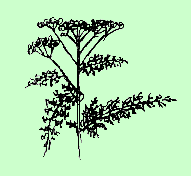|
|
YARROW

 The yarrow is a familiar wayside plant. Its name is said to be a contraction
of "Ye Arrow", referring to its arrow shaped leaf stems. The finely dissected
leaves are the basis for the scientific name Achillea millefolium
(thousand leaves). The stems are tall or short, depending on where it grows,
in a wet meadow or on a dry hillside. It has tiny, grayish white flowers in
a flat topped cluster. A fragrant, nutlike odor is an unforgettable
characteristic.
The yarrow is a familiar wayside plant. Its name is said to be a contraction
of "Ye Arrow", referring to its arrow shaped leaf stems. The finely dissected
leaves are the basis for the scientific name Achillea millefolium
(thousand leaves). The stems are tall or short, depending on where it grows,
in a wet meadow or on a dry hillside. It has tiny, grayish white flowers in
a flat topped cluster. A fragrant, nutlike odor is an unforgettable
characteristic.


 Once considered a potent love charm, young girls tucked yarrow into their
high topped shoes, singing:
Once considered a potent love charm, young girls tucked yarrow into their
high topped shoes, singing:
"Yarrow, Yarrow, I do pluck thee.
In my shoe top I do tuck thee.
The next boy who smiles at me,
My true love, he shall be."

 The yarrow has been considered a good medicinal plant since ancient times.
Achilles, who legend tells was dunked in a brew of yarrow to give him
immortality, is said to have made an ointment from yarrow to heal his
wounded men. The plant is sometimes called "Nosebleed" because it was used
to induce nosebleeds in order to try to cure headaches. The Swedish made
an intoxicating beer from yarrow.
The yarrow has been considered a good medicinal plant since ancient times.
Achilles, who legend tells was dunked in a brew of yarrow to give him
immortality, is said to have made an ointment from yarrow to heal his
wounded men. The plant is sometimes called "Nosebleed" because it was used
to induce nosebleeds in order to try to cure headaches. The Swedish made
an intoxicating beer from yarrow.

 Yarrow is world wide in distribution, but some persons believe that it came
to North America long ago from Europe and Asia. The western species is
A. lanulosa, named because the leaves have wooly surfaces. The
leaves are eaten by the following wildlife: Ruffed Grouse, Sharp Tailed
Grouse, Cottontail Rabbit, Pine Mouse, and Mountain Sheep.
Yarrow is world wide in distribution, but some persons believe that it came
to North America long ago from Europe and Asia. The western species is
A. lanulosa, named because the leaves have wooly surfaces. The
leaves are eaten by the following wildlife: Ruffed Grouse, Sharp Tailed
Grouse, Cottontail Rabbit, Pine Mouse, and Mountain Sheep.
 -- by Adrianne Montgomery
-- by Adrianne Montgomery
|
|

